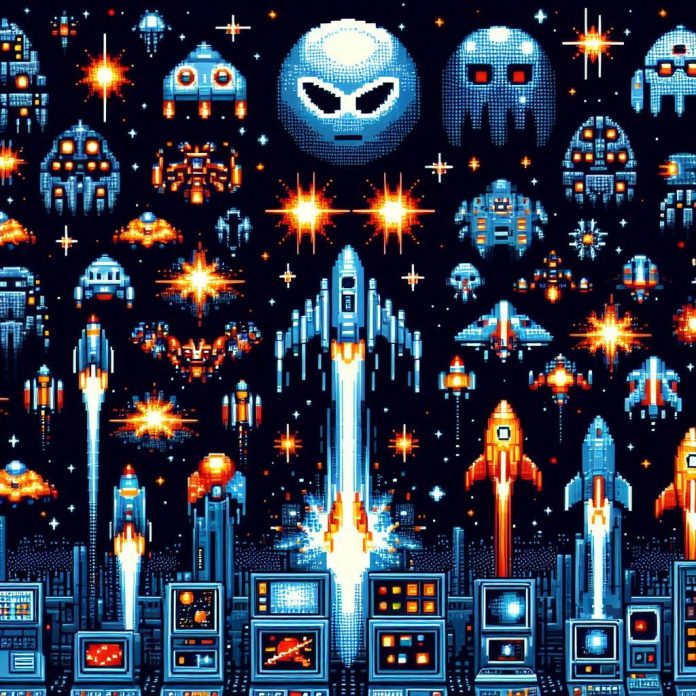The allure of space has captivated the human imagination for centuries, fueling dreams of exploration, adventure, and the unknown. This fascination has seamlessly transcended into the realm of video games, where sci-fi space shooters have carved out a unique and enduring niche.
From the pixelated invaders of the early arcade days to the sprawling, immersive universes of modern gaming, these titles offer players the chance to pilot spacecraft, engage in interstellar dogfights, and unravel cosmic mysteries.
Sci-fi space shooters are a genre that marries the excitement of high-octane action with the speculative wonder of science fiction. They provide a canvas for developers to paint vivid, imaginative worlds where players can escape the constraints of reality and embark on epic adventures among the stars.
Whether it’s battling alien armadas, trading goods across galaxies, or exploring uncharted territories, these games offer a diverse range of experiences that cater to various tastes and preferences.
In this article, we will journey through the evolution of sci-fi space shooters, highlighting some of the most iconic and influential titles that have left an indelible mark on the genre. From the pioneering classics that laid the groundwork to the cutting-edge modern masterpieces and the innovative indie gems, we will explore the best sci-fi space shooter games that have defined and continue to shape this exhilarating genre.
So, strap in, power up your thrusters, and prepare for a voyage through the stars as we celebrate the very best in sci-fi space shooters.
The landscape of sci-fi space shooters has evolved dramatically over the years, but the foundation of this genre was laid by a series of iconic classics that still hold a special place in the hearts of gamers. These pioneering games not only defined the mechanics and aesthetics of space shooters but also established benchmarks for future innovations. Let’s journey back in time to revisit some of the most influential classic sci-fi space shooters.
Space Invaders
Released in 1978 by Taito, “Space Invaders” is often credited with revolutionizing the video game industry. Designed by Tomohiro Nishikado, this groundbreaking game introduced players to the thrill of defending Earth from waves of descending alien invaders. Armed with a laser cannon, players had to strategically move left and right, shooting at the advancing aliens while taking cover behind destructible barriers.
The game’s simple yet addictive gameplay, combined with its increasing difficulty, created a sense of urgency and excitement that captivated millions. “Space Invaders” not only became a cultural phenomenon but also inspired countless sequels and adaptations, cementing its status as a timeless classic in the sci-fi space shooter genre.
Galaga
Following closely on the heels of “Space Invaders,” Namco’s “Galaga” hit the arcades in 1981 and quickly became a beloved classic. As a sequel to “Galaxian,” “Galaga” introduced more complex mechanics and refined graphics, elevating the player experience. In “Galaga,” players control a starfighter tasked with shooting down formations of alien ships that swoop and dive in intricate patterns.
One of the game’s standout features is the ability for the player’s ship to be captured by enemy forces, only to be rescued later, allowing for dual-ship gameplay with doubled firepower. This innovative mechanic, along with challenging boss battles and bonus stages, made “Galaga” a standout title that continues to be celebrated in gaming communities around the world.
Asteroids
Created by Atari and released in 1979, Asteroids offered a fresh take on the space shooter genre with its vector graphics and unique gameplay mechanics. Players pilot a triangular spaceship in an asteroid field, tasked with shooting and destroying asteroids and flying saucers while avoiding collisions. The game’s physics-based movement, which includes inertia and momentum, added a layer of complexity and realism that set it apart from its contemporaries.
Asteroids was lauded for its minimalist yet captivating design, and its high replay value ensured that it remained a staple in arcades for years. The game’s influence is evident in many modern space shooters that incorporate physics-based movement and destructible environments.
These classic sci-fi space shooters not only laid the groundwork for the genre but also demonstrated the enduring appeal of battling extraterrestrial threats in the vastness of space. Their legacy continues to inspire game developers and captivate new generations of players, proving that great gameplay is truly timeless.
Modern Sci-fi Space Shooters
The landscape of sci-fi space shooter games has evolved dramatically with advancements in technology. Modern titles offer players intricate narratives, expansive universes, and visually stunning graphics that push the boundaries of what was once thought possible in gaming. Here, we delve into three of the most influential modern sci-fi space shooters: EVE Online, Elite Dangerous, and Star Citizen.
EVE Online
Released in 2003 by CCP Games, EVE Online is a massively multiplayer online game (MMO) that has captivated players for nearly two decades. Set in a complex galaxy known as New Eden, the game features over 7,800 star systems, each filled with opportunities for exploration, combat, and economic domination.
EVE Online stands out due to its intricate player-driven economy and political systems. Players can engage in mining, trading, piracy, and large-scale fleet battles. The game’s real-world economy is so sophisticated that it has attracted the attention of economists, and its political intrigue has spawned countless stories and legends within the gaming community.
The learning curve for EVE Online is notoriously steep, but for those who invest the time, the rewards are substantial. The game offers a depth and realism that few other titles can match, making it a cornerstone of modern sci-fi space shooters.
Elite Dangerous
Elite Dangerous, developed and published by Frontier Developments, launched in 2014 and serves as the latest installment in the Elite series. The game is renowned for its 1:1 scale representation of the Milky Way galaxy, featuring 400 billion star systems. This staggering level of detail creates a sandbox environment where players can freely explore, trade, and engage in combat.
The game offers various roles for players to assume, such as trader, bounty hunter, pirate, or explorer. The flight and combat mechanics are highly detailed, requiring skill and precision to master. Elite Dangerous also supports both single-player and multiplayer modes, allowing for a versatile gaming experience.
One of the standout features of Elite Dangerous is its commitment to realism. The developers have worked closely with scientists to ensure that the game’s astronomical data is as accurate as possible. This attention to detail enhances the immersive experience, making players feel like true spacefarers navigating the cosmos.
Star Citizen
Star Citizen is perhaps the most ambitious project in the realm of modern sci-fi space shooters. Developed by Cloud Imperium Games and led by industry veteran Chris Roberts, the game has been in development since 2011 and has raised over $400 million through crowdfunding.
Star Citizen aims to create a persistent universe where players can engage in a wide array of activities, from space combat and exploration to trading and social interactions. The game promises unprecedented levels of detail and realism, with a fully simulated economy and NPC population.
One of the unique aspects of Star Citizen is its modular development approach. The game is being released in stages, with various modules such as Arena Commander (space combat), Star Marine (first-person shooter), and the Persistent Universe being made available as they are completed. This allows players to experience parts of the game while it is still in development.
The scope and scale of Star Citizen are unparalleled, and its ambitious vision has garnered a dedicated fan base. While the game’s full release is still pending, its existing modules offer a glimpse into what could be the most comprehensive and immersive sci-fi space shooter ever created.
Indie Sci-fi Space Shooters
Indie games have been a fertile ground for innovation and creativity, often bringing fresh perspectives and unique gameplay mechanics to well-trodden genres. This is especially true for indie sci-fi space shooters, where developers have crafted experiences that rival, and sometimes even surpass, those produced by larger studios.
Here, we’ll explore three standout titles: FTL: Faster Than Light, No Man’s Sky, and Rebel Galaxy.
FTL: Faster Than Light
FTL: Faster Than Light is a prime example of how indie developers can infuse depth and complexity into seemingly simple gameplay mechanics. Developed by Subset Games, FTL combines strategic space combat with rogue-like elements, creating an experience that is both challenging and highly replayable. Players take on the role of a starship captain tasked with delivering crucial information to the Federation.
Along the way, they must manage their crew, upgrade their ship, and make critical decisions that could mean the difference between survival and destruction.
What sets FTL apart is its emphasis on real-time strategy and resource management. Players must juggle power allocation, crew assignments, and tactical maneuvers, all while facing random encounters that can drastically alter the course of their journey. The game’s permadeath feature ensures that every decision carries weight, making each playthrough a unique and suspenseful adventure.
No Man’s Sky
When No Man’s Sky was first released by Hello Games, it was met with mixed reactions. However, through numerous updates and expansions, the game has evolved into one of the most expansive and immersive sci-fi space shooters available. At its core, No Man’s Sky offers a procedurally generated universe with over 18 quintillion planets, each with its own ecosystem, flora, and fauna. This vastness allows for unparalleled exploration, making every player’s journey truly unique.
The game combines elements of survival, crafting, and combat, offering a well-rounded experience that appeals to a wide range of players. Whether you’re mining resources, building bases, or engaging in dogfights with hostile forces, No Man’s Sky provides a sense of wonder and discovery that is hard to match. The game’s continuous updates have added features like multiplayer, underwater exploration, and even VR support, ensuring that it remains a staple in the indie sci-fi space shooter genre.
Rebel Galaxy
Rebel Galaxy, developed by Double Damage Games, offers a different take on the space shooter genre. Instead of the traditional cockpit or top-down view, Rebel Galaxy places players in command of massive, capital-class ships. The game focuses on naval-style combat, where positioning, broadside attacks, and strategic use of turrets play crucial roles.
Set in a gritty, outlaw-infested universe, Rebel Galaxy allows players to carve their own path. You can choose to be a mercenary, trader, pirate, or even a miner. The game’s open-world nature and dynamic economy provide a backdrop for countless adventures, ensuring that no two playthroughs are the same. With its engaging narrative, vibrant graphics, and a soundtrack that perfectly complements its space-western theme, Rebel Galaxy stands out as a must-play title for fans of indie sci-fi space shooters.
Conclusion
The universe of sci-fi space shooter games is vast and ever-expanding, offering a rich tapestry of experiences for gamers of all generations. From the pixelated charm of classic titles like Space Invaders, Galaga, and Asteroids to the intricate, immersive worlds of modern giants such as EVE Online, Elite Dangerous, and Star Citizen, each game has contributed uniquely to the genre.
Classic sci-fi space shooters laid the groundwork, establishing key gameplay mechanics and themes that continue to influence the genre today. Their simplicity and addictiveness remain timeless, proving that compelling gameplay transcends technological advancements. These pioneering titles also set a precedent for the sense of wonder and exploration that is so integral to sci-fi gaming.
Modern sci-fi space shooters have taken the foundation laid by their predecessors and built upon it exponentially. With advanced graphics, complex narratives, and expansive, open-world environments, games like EVE Online, Elite Dangerous, and Star Citizen offer players a level of depth and immersion that was previously unimaginable. These games not only provide thrilling combat experiences but also incorporate elements of strategy, economics, and diplomacy, creating a multifaceted gaming experience.
Indie developers have also made significant contributions to the genre, often bringing fresh perspectives and innovative gameplay mechanics. Titles like FTL: Faster Than Light, No Man’s Sky, and Rebel Galaxy demonstrate that smaller studios can produce high-quality, engaging games that resonate with players.
These games often emphasize creativity and experimentation, offering unique takes on space exploration and combat that distinguish them from their mainstream counterparts.
In conclusion, the sci-fi space shooter genre continues to evolve, driven by both technological advancements and the creative visions of game developers. Whether you are a fan of the nostalgic classics, the sprawling modern epics, or the inventive indie gems, there is a sci-fi space shooter out there that will capture your imagination and transport you to the stars.
As we look to the future, one thing is certain: the allure of space and the thrill of interstellar combat will continue to inspire gamers and developers alike, ensuring that this genre remains a vibrant and essential part of the gaming landscape.
<iframe width="560" height="315" src="https://www.youtube.com/embed/1jI5tnS5Oek?si=3cUrsKrL3lBvZLwo" title="YouTube video player" frameborder="0" allow="accelerometer; autoplay; clipboard-write; encrypted-media; gyroscope; picture-in-picture; web-share" referrerpolicy="strict-origin-when-cross-origin" allowfullscreen></iframe>




.jpg?w=100&resize=100,70&ssl=1)
